Porto-North-Portugal.com
The best independent guide to Porto
Porto-North-Portugal.com
The best independent guide to Porto
Porto in One Day: A Suggested Walking Tour for 2026
Porto is a city rich with historic monuments, charming districts, and a vibrant culture. While it is a destination that rewards in-depth exploration, it is possible to see many of its main highlights in a single, fast-paced day of sightseeing.
Ideally, two days are recommended to fully appreciate all that Porto has to offer, but for visitors constrained by time - such as cruise ship passengers or those on a long flight layover - a well-planned walking tour can provide a fantastic snapshot of the city. This itinerary is designed to be efficient, focusing on the most important sights within the compact and walkable historic centre.
The proposed route will guide you through the medieval alleys of the Ribeira district, past the magnificent azulejo tilework of São Bento Station, up to the commanding viewpoint of the Sé Cathedral, and across the iconic Dom Luís I Bridge for a brief taste of the Port cellars in Vila Nova de Gaia.
This guide provides a detailed one-day itinerary, complete with a map, designed to help you experience the very best of Porto when your time is limited.
1 day tour of Porto - the map
This walking tour covers the main sights of Porto and is a fantastic introduction to the city. Below is an interactive map of the suggested 1-day walking route:
Sights along the route: 1) Praça da Liberdade 2) Torre dos Clérigos 3) Antiga Cadeia da Relação 4) Santo António Hospital (Neoclassical façade) 5) Igreja do Carmo 6) University of Porto 7) Livraria Lello bookshop 8) São Bento train station 9) Se Cathedral 10) Luís I bridge 11) Mosteiro da Serra do Pilar 12) Port cellars and Port tasting 13) Half Rabbit urban art 14) Estaleiro do Rabelo boat yard 15) Ribeira district 16) Casa do Infante 17) Igreja de São Francisco 18) Palácio da Bolsa 19) Igreja da Misericórdia 20) Rua das Flores 21) Igreja de Santo Ildefonso church 22) Majestic Café 23) Bolhão market 24) Câmara Municipal
The best Port cellars for Port tasting and tours are marked on the map by a ![]() symbol.
symbol.
The route is 8.8km and takes around 6 hours of sightseeing, and will be longer when lunch and coffee breaks are included.
There are many steep hills in Porto, so expect a lot of uphill walking. The steepest hill of the route is just before the Santo Ildefonso church (21), and depending on your energy levels, this may be a convenient location to end the walking tour.
Guide to the 1-day walking tour
This section provides details of the walking tour and included images of the main sights along the route.
The tour begins in the Praça da Liberdade (1), the main plaza of Porto. This plaza is the connection between the modern city to the north and the medieval districts to the south.
At the head of the Praça da Liberdade is the magnificent Câmara Municipal (24) while surrounding the entire plaza is imposing 1920s granite architecture.
Insight: The McDonald's in the Praça da Liberdade is regarded as the most beautiful McDonald's in the world. It was originally the grand Cafe Imperial, and the conversion retained all of the art deco features, including stain glass mirrors and extravagant chandeliers.
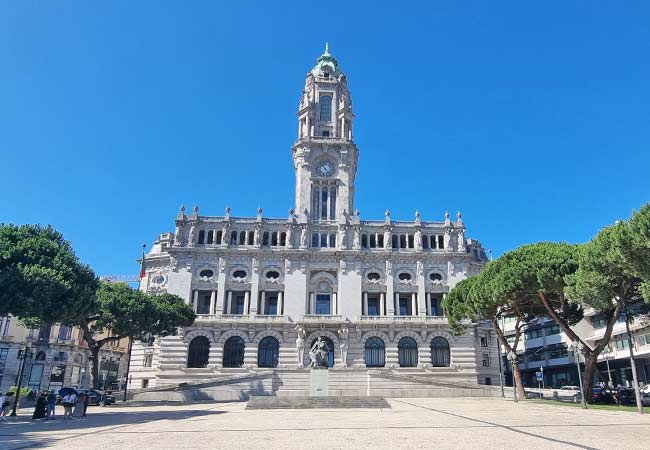
The Câmara Municipal do Porto
To the west of the Praça da Liberdade is the Igreja dos Clérigos. This baroque church has a unique oval nave, designed by the celebrated Italian architect Nicolau Nasoni, but most visitors are drawn by the adjacent Torre dos Clérigos (2).
The tower at 75m is the highest structure in the historic centre of Porto, and if you climb the 240 steps, you will be rewarded with some of the finest views of Porto.
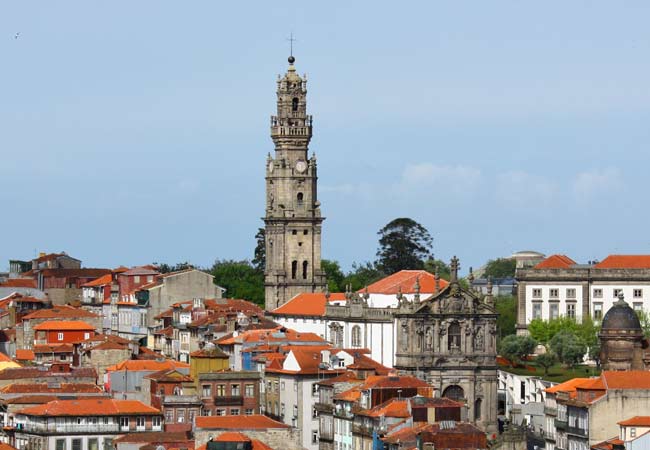
From its construction in 1763 until the late 20th century the Torre dos Clérigos was the tallest building in Portugal
Further along, is the tree-lined Jardim da Cordoaria park and the Antiga Cadeia da Relação (3), Porto's original prison. Today the prison complex houses the informative Fotografia Museum.
Heading around the park is the imposing Tribunal da Relação do Porto and the Neo-classical wing of the Santo António Hospital (4).
On the northern side of the Jardim da Cordoaria is the Igreja dos Carmelitas, the Igreja do Carmo (5) and the main campus of Porto University (6). Being close to the university, this area is a hub for nightlife with many trendy bars and nightclubs.
The Igreja do Carmo is famed for the beautiful blue and white tile mural that covers the entire eastern wall and was created using traditional azulejo tile paintings.
Insight: An ancient law prevented two churches sharing the same wall, so separating the Carmelitas and Carmo churches is Portugal's narrowest house. This now has been turned into a museum and is part of the Igreja do Carmo.
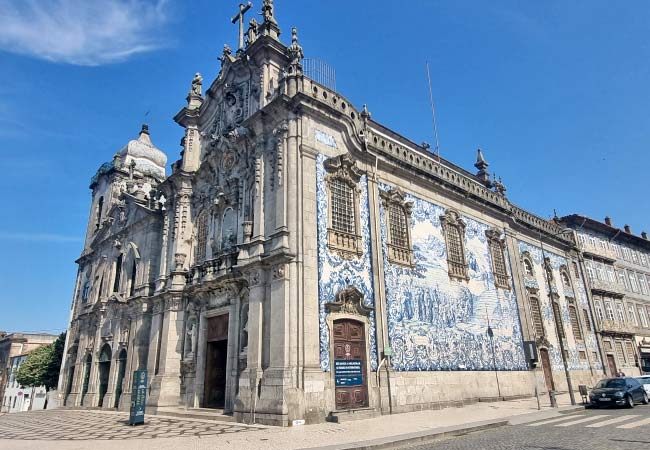
The decorative painted tiles on the side of the Igreja do Carmo
Departing from the Praça de Parada Leitão is the number 22 tram, which provides a scenic loop of central Porto. The tram route takes 45min, costs €3 and is a relaxing method to see the city, so long as you can get a seat!
The next sight is the Livraria Lello bookshop (7), where JK Rowling wrote the initial chapters of the Harry Potter series, and was the inspiration for the grand staircase in Hogwarts. The shop is always crowded and changes €6 to enter.
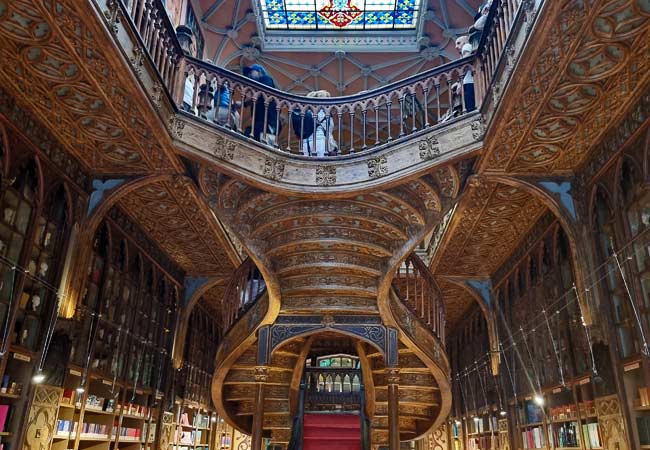
Livraria Lello Bookshop
Heading downhill leads to the São Bento train station (8) with its beautiful concourse decorated with some of the finest Azulejo tile paintings in Portugal.
Insight: There are two styles of tile paints in the station, traditional blue and white painted before the 1910 revolution and colour tiles painted after.
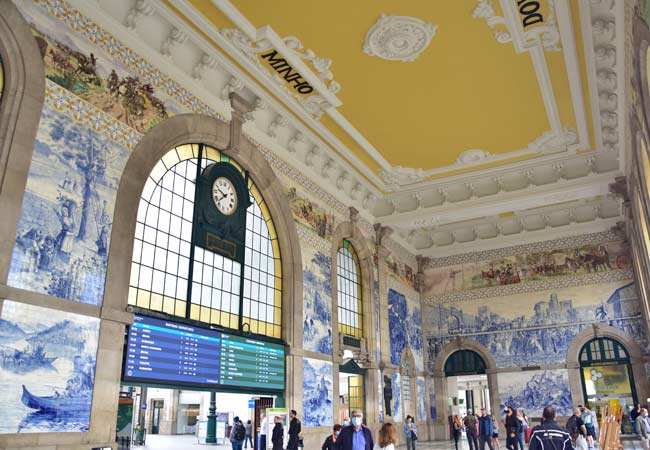
Inside São Bento train station
Uphill from the station is the ancient Se Cathedral (9) with its stark Romanesque fortified appearance. The interior of the cathedral is very austere, but the gothic cloisters have more character and are worth a visit.
The plaza in front of the cathedral was the centre of medieval Porto, hosting a daily market and protected by the city walls. The only remaining defensive tower houses the tourism office, and at the centre of the plaza is a pillory, used to hang criminals.
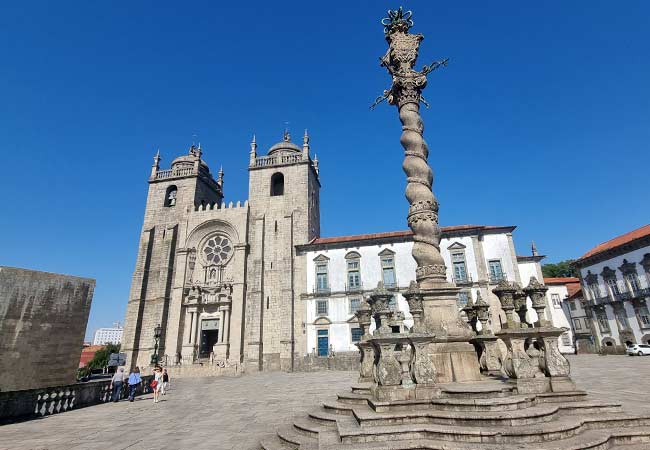
The Se Cathedral was constructed as a statement of religious dominance
If you enjoy decorative churches, then do include a visit to the Igreja de Santa Clara, with its ornate carved altars and lavish use of gold leaf.
South from the Se Cathedral leads to the iconic Luís I Bridge (10), a wonderous iron bridge with two levels spanning the Douro River. This route crosses the upper deck of the bridge and offers stunning views over the historic riverside districts of Porto.
Insight: Before the construction of the Luis I bridge the Douro River was crossed by the Ponte das Barcas, a bridge constructed from twenty-one old Rabelo boats lashed together. The bridge sunk during the invasion of Napoleon's army in 1809 as the city fled, causing the loss of 400 people. The columns which held the Ponte das Barcas can be still seen next to the Ponte Luis I.
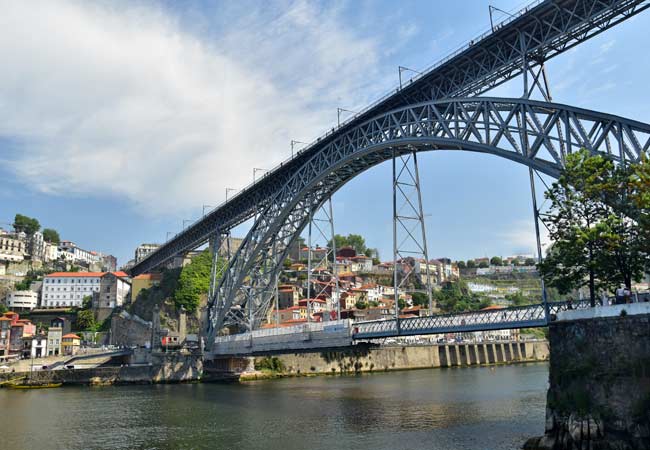
The Luís I Bridge connects Porto on the north side of the Douro with Vila Nova de Gaia on the south side
Note the Ponte das Barcas columns on the left of the bridge
For an even better view of the river head up to the viewing terrace within the Mosteiro da Serra do Pilar (11), this monastery complex is unique for its circular church.
Just below the monastery is the Jardim do Morro, a popular location to hang-out during the summer months.
Departing from the edge of the park is a cable car down to the waterfront of Vila Nova de Gaia, but as it's all downhill from the Jardim do Morro, it's just as easy to walk.
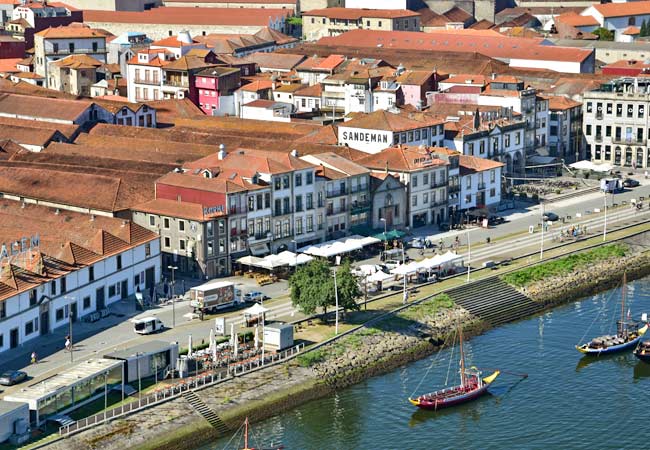
The waterfront of Vila Nova de Gaia with the Port cellars to the rear
Vila Nova de Gaia is the traditional home of Porto wine, and the drink is matured in the vast cellars that line the banks of the river.
Within Vila Nova de Gaia are all of the major Port producers, and they provide guided tours of their cellars along with Port tasting sessions.
The best tours and tastings include; Ferreira, Sandeman, Cálem, Graham's and Churchill.
Insight: There is always a great atmosphere along the riverside in Vila Nova de Gaia, and it is an enjoyable place to relax and socialise.
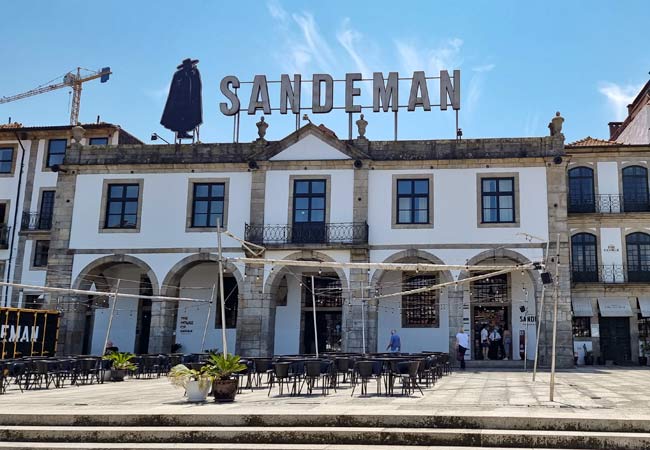
After a Port tasting session, you may just wish to embrace the unhurried culture of Portugal
While wandering Vila Nova de Gaia do visit the "Half-Rabbit" (13), a distinctive piece of urban art constructed purely from discarded rubbish, which is close to the Igreja Santa Marinha church.
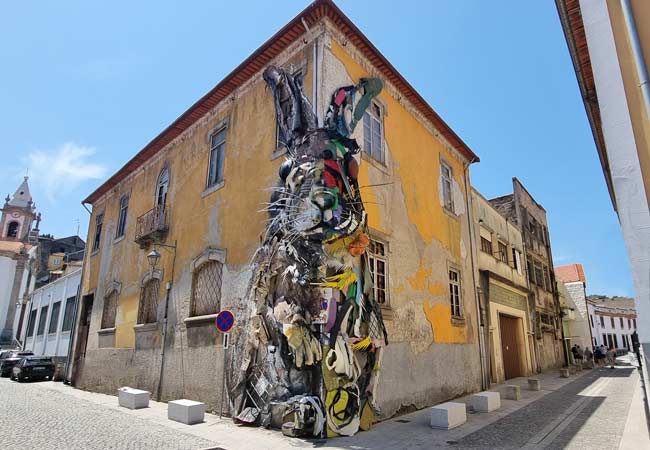
Both sides of the Half Rabbit are only seen if you look at the corner of the building
At the far end of the Vila Nova de Gaia is the Estaleiro do Rabelo (14), a traditional shipyard which builds and repairs the Rabelo boats. These flat-bottomed boats were historically used for transporting barrels of crushed grapes from the upper reaches of the Douro to the cellars in Vila Nova de Gaia.
After exploring Vila Nova de Gaia, cross the lower level of the Luís I Bridge, which leads into the Ribeira district.
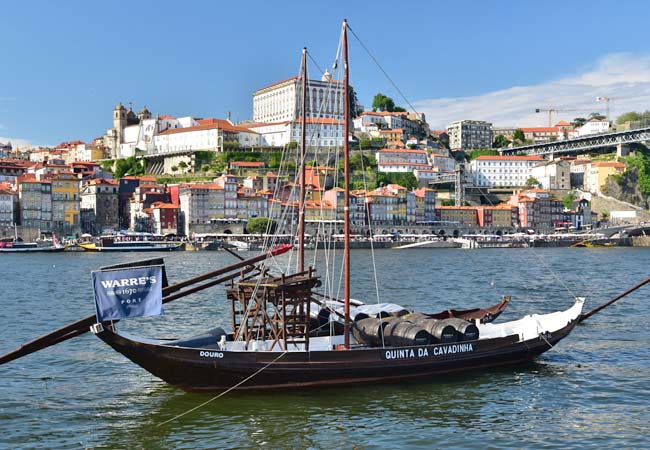
The Ribeira district as seen from Vila Nova de Gaia
Historically the Ribeira were the docks of Porto and one of the poorest areas of the city, but today it is one of the most characterful districts.
Along the waterfront restaurants and bars are crowded with tourists, while standing above the shops are a colourful hotch-potch of ancient houses.
At the heart of the district is the charming Praça da Ribeira, and much like Vila Nova de Gaia waterfront, there is always a buzzing atmosphere.
The unassuming Casa do Infante (16), was the birthplace for Henry the Navigator, the noble who instigated the 14th century "Age of Discovery", which ultimately led to the discovery of Brazil and the sea route to India. Inside the Casa do Infante is a museum detailing his life and the sea voyages.
Across the street is the departure location for the Linha 1 tram, which trundles down the Douro to the mouth of the mighty river and the charming Foz district. This is a pleasant area to explore if you have a second day in Porto.
The São Francisco monastery was the grandest religious building of Porto, until it was accidentally burned down during the Siege of Porto in 1832. All that remains today is the Igreja de São Francisco (17).
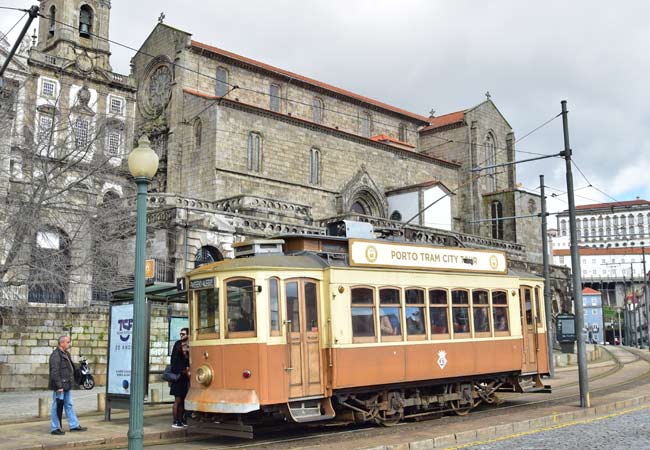
The number 1 tram waiting in front of the Igreja de São Francisco
From the outside, the church appears as yet another sombre gothic building, but inside is a profusion of intricate wood carvings and excessively adorned altars.
Insight: Such was the extensive use of gold leaf, that it is estimated that the Igreja de São Francisco contains over 100kg of gold.
The Neoclassical Palácio da Bolsa (18) was the stock exchange of Porto and represented the financial importance of the city during the 19th century. This "palace" was constructed on the fire ravaged cloisters of the São Francisco monastery. Inside is the wonderous Arab Room, the grand Hall of Nations and an impressive central courtyard.
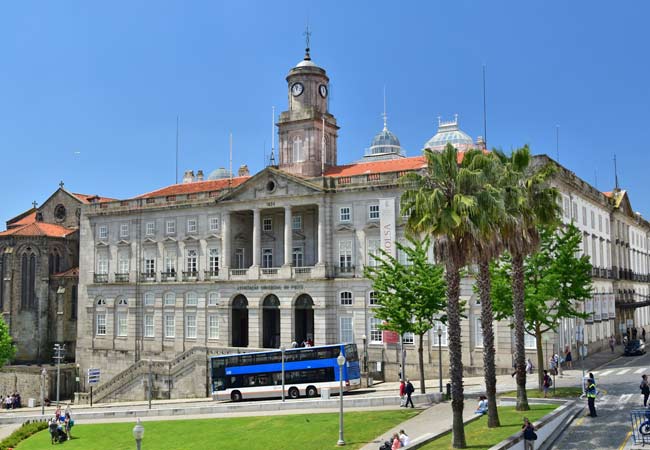
The Palácio da Bolsa
The Misericórdia (The Mercy) were a 17th-century charity in which Porto's nobles donated money to fund hospitals and care for the poor of the city. The Museu da Misericórdia do Porto (19), exhibits portraits of the donors and provides entrance to the lavish Igreja da Misericórdia. Within the museum is the "Fons Vitae", Portugal's finest gothic painting.
The Rua das Flores (20) is one of Porto's best shopping streets and is filled with independent stores, quirky tourist stalls and family-run cafes, along with a host of street performers.
The pretty Igreja de Santo Ildefonso church (21) is adorned with over 11,000 azulejo tiles covering the entire exterior of the church. The church is worth visiting, except it is at the top of a very steep hill.
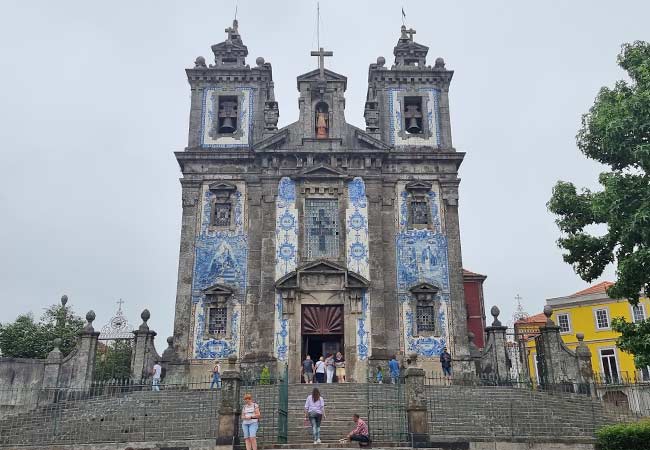
The Igreja de Santo Ildefonso is decorative and unique, but it's a demanding climb to see it!
The Majestic Café (22) is one of Porto's original Art Nouveau styled cafes. The café, with its original features and hectic atmosphere, is bursting with character, and a great location for a mid-afternoon coffee and delicious Portuguese pastry.
The Rua de Santa Catarina, on which the Majestic Café is situated, is at the heart of Porto's shopping district and is a pleasant area to browse shops.
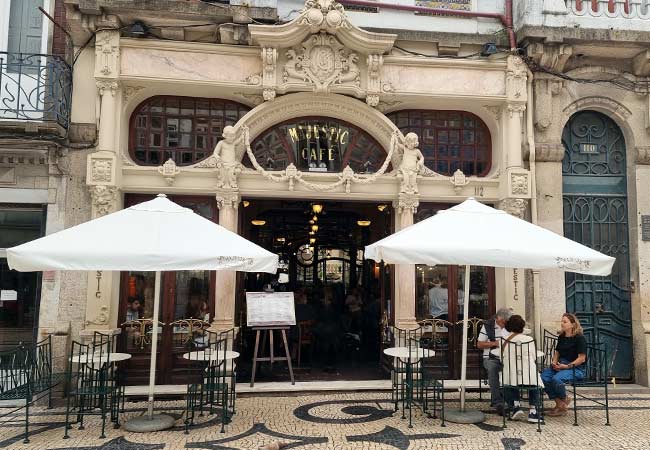
The Art Nouveau styled Majestic Café, was inspired by Parisian cafés
The Bolhão market (23) is the traditional market of Porto, filled with local produce (flowers, vegetables and meats), handicrafts and gifts. If you are seeking to experience a slice of authentic Porto, a stroll around this bustling market is for you.
Insight: The market starts early in the day, and by mid-afternoon, many of the fresh produce have been sold. If you enjoy visiting markets, consider adding Bolhão market much earlier in the day.
The tour then leads back into the Praça da Liberdade and the Câmara Municipal do Porto (24).
If you’re taking this tour from a cruise ship or while waiting for a flight
The walking tour starts from the Praça da Liberdade (1).
If you are travelling from the airport, catch the metro from the airport to the Trindade metro station (zone 4 ticket - €2.25, 27min journey) and walk south along the Avenida dos Aliados. A second metro could be taken from Trindade station to Aliados, but the journey is only 500m, and the walk is downhill.
Cruise ships to Porto moor at the Terminal de Cruzeiros do Porto de Leixões (GPS: 41.17739, -8.69984) in the town of Matosinhos. The 500 bus route provides a direct and regular bus service between Matosinhos to the Praça da Liberdade in Porto.
The nearest bus stop to the cruise terminal is "Godinho" (GPS: 41.18161, -8.69215), and a single fare to Porto costs €1.80, with a 40 minutes journey time. This is a very scenic bus route as it follows the Douro River.
Warning: Always allow sufficient time to travel back to the airport or cruise terminal.
If you've enjoyed our content, we'd like to ask for your support.
The internet landscape has changed, and small independent publishers like us face increasing challenges. Search engines now prioritize advertising over organic content, reducing our traffic, while AI systems increasingly copy our original work without attribution.
To help support us, please consider bookmarking our website for easy access. If you find an article useful, we encourage you to share it with friends or on social media. Equally, if you notice anything outdated or incorrect, please let us know so we can promptly address it.
We're always open to collaborating with brands, bloggers, and SEO/PR agencies who value independent creators. If you'd like to work with us or offer support, please reach out at: [email protected]
Thank you for being part of our community and helping us continue to provide valuable content in an increasingly challenging digital environment.
























